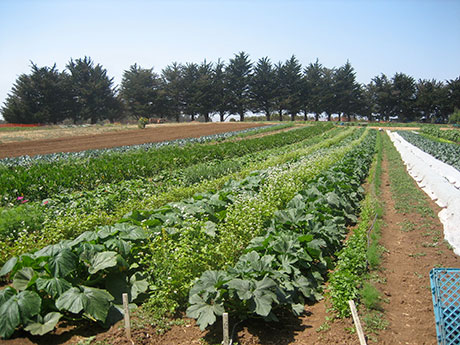Our food supply is neither secure or sustainable
Posted by Casey Hrynkow on Wednesday, October 23rd, 2013Tags for this Article: Casey Hrynkow, Dangling0, food supply, local, sustainability

Small, local mixed-crop farmers are a dying breed. The average age of a BC farmer is 59 years. Despite the great urban farming efforts of good people like Sole Food Street Farms and Fresh Roots, making a living as a farmer is not sustainable under current conditions. Small farmers are not making enough money for the food they grow. They have second jobs, and the farm keeps losing money. What that means is that we depend more and more on big factory farms growing massive swaths of monocultures to be our only source of food. Think about it. Living off chemically fertilized, chemically pest-protected food that is harvested under ripe and shipped thousands of miles. Then think about that one virus — that one pest that beats the chemicals and thrives.
Our food supply is neither secure or sustainable.
My name is Casey Hrynkow. I’ve been working on a food project for the last 6 months called Dangling the Local Carrot. My ultimate goal with this project is to find a way to make local produce more accessible and affordable in Metro Vancouver.
I have looked in a number of directions, with the three main groups being Education, Technology and Distribution. All of the expert interviews I’ve had have told me Distribution is the pinch point to getting farmers a decent return on their labour. That would ensure the survival of current small mixed-crop farms, and the succession of those farmers.
I am at the point where I have begun to consider the idea of a Food Hub for Metro Vancouver. This would be a place for produce to be collected, sorted, washed, bundled and shipped out to customers. It would be a place with a commercial kitchen to use during the growing season and to rent in the off season. During that off season, farmers could come in, share ideas about the next seasons’ planting and get new training in technology and business. If you are familiar with the planned New City Market, I see this concept as slightly simpler and, perhaps, a piece that fits with the Market. I have yet to speak with anyone at Local Food First, but will follow up this week.
As my project (at least within the Leading by Design Fellows Program at California College of the Arts in San Francisco) is drawing to a close, with a presentation due November 1, I am looking for expert input on some of my very rough ideas. If you are someone in finance, farming, food processing, food retail, food education, farm education, food wholesale, a restaurateur, a caterer or someone in government who knows about food distribution and/or farming, I would be so grateful for your input. You can find my 10-question survey here.
What I hope to present at California College of the Arts on November 1 is a business model for further development. I know that the regulation and consultation around a project like this often takes years, so I am under no illusion that a perfected Food Hub will magically appear, but I see value in it, and the dozens of experts I have spoken to this far also see value in it. So, I will proceed and hope that the planets align. As a partnership with project already in development or going it alone, I think this carrot has legs.
Please take a few moments to fill out this short survey.


Posted on October 23rd, 2013
foodists says:
Our Food Supply Is Neither Secure Or Sustainable. Pls take this survey:
http://t.co/LZrGO6kdr0
Posted on October 23rd, 2013
MarkBusse says:
Our food supply is neither secure or sustainable http://t.co/r3C9aliCWC
Posted on October 24th, 2013
Brett Macfarlane says:
Great initiative. I’m curious, have you considered a fourth pillar – perception? In a country like Canada that essentially started as monoculture with the first European settlers, local reads as exclusive, priviledged and expensive. But obviously there are many positives that make the premium attractive. Equally, perception relates to behavior change – logistic and access are great, as well as knowledge, but that rarely also leads to usage (speaking from experience from many brands and categories.) In Europe the behavior is around either regular markets for everyone not just foodies, annual festivals at peak harvest or traditions of preservation to extend the consumable time frame. In modern times it is also about no-sacrifice convenience with brands like Abel & Cole doing the business/logistic things right but really excelling at bringing people into a culture of considered food and many small fun origin stories (rather than the usual pedantic or motherly tone of local/organics.) Thus making the ongoing behavior of local food more compelling on all fronts thanks to a more accessible perception. Everything you are doing is great, and correct, it would be interesting to think beyond the human growing the stuff to the human psychology of the humans that will use the stuff.